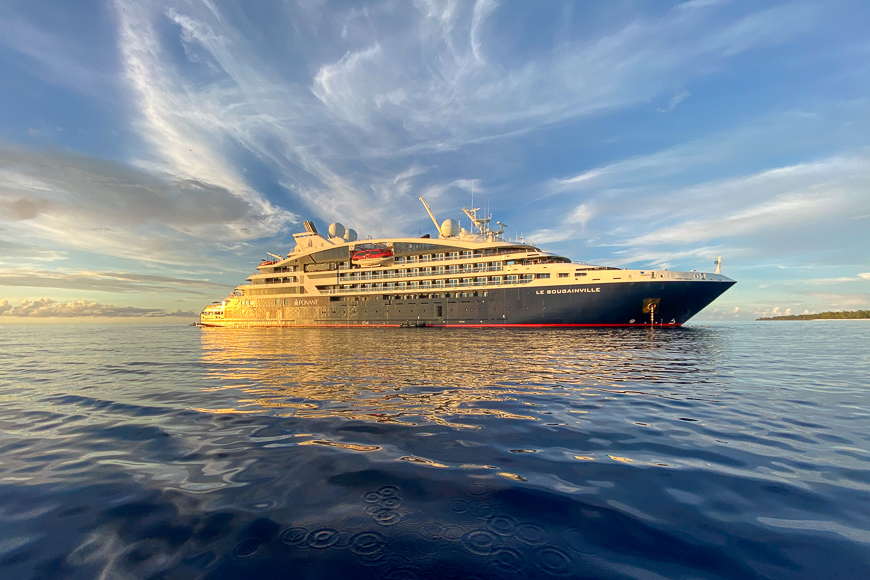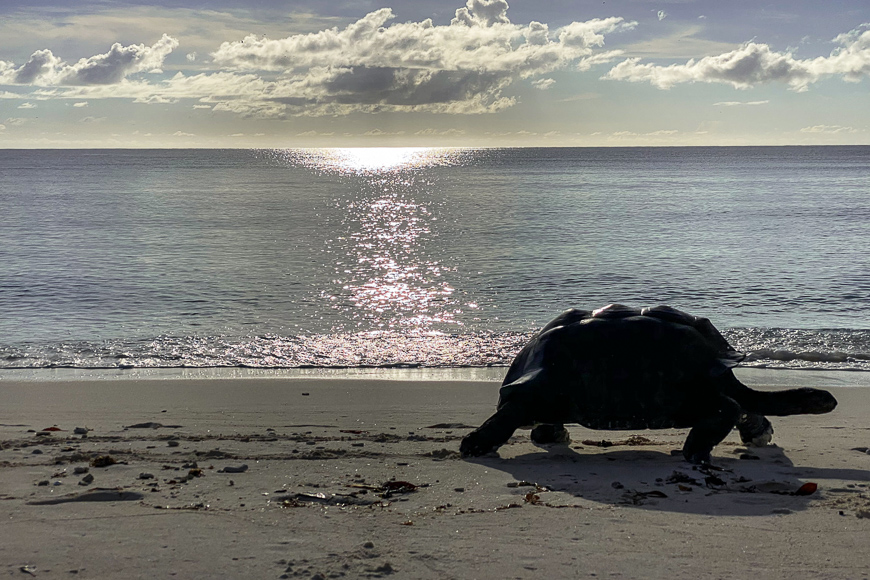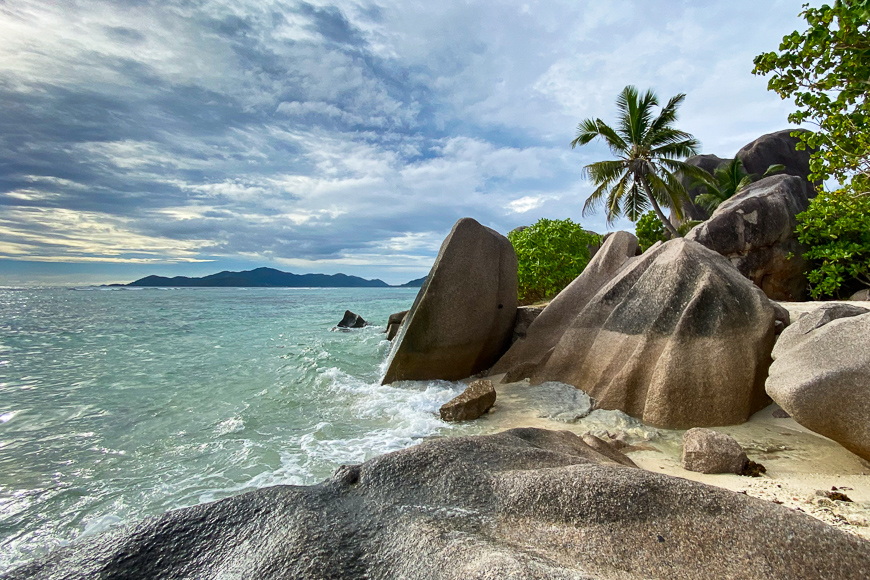An expedition cruise conjures up a picture of explorers suffering through harsh conditions to experience some of the most secret corners of the globe. Of rations and camping in battered tents aboard a cold freighter. With Zegrahm Expeditions, an expedition cruise meant surprise macarons on the beach and a floating bar in the bluest, warmest ocean you’ve ever seen—all while still seeing those same hidden places previously reserved for tough explorers.
And yet, on even on a comfortably luxurious cruise ship, I found myself surrounded by explorers. There’s something different about the people you meet onboard an expedition cruise. It wasn’t your standard group of tourists who were just there for the buffet. It was three-course meals eaten next to the only person in the world who’s stood on the bottom of the Door to Hell in Turkmenistan, sitting in a zodiac with someone about to embark on a round-the-world private jet cruise, and drinking a sunset cocktail next to a traveler who could tell me what Tibet was like in the 70s. Every conversation referenced places I couldn’t find on a map, but immediately added to my bucket list.
Meeting people like the gentleman in his 80s who was nearly to his goal of visiting all the national parks in the U.S. and Canada sparked a promise to myself to never stop traveling, learning, or appreciating life.
A Trip Unlike Any Other

The Greek Philosopher Heraclitus said, “you cannot step in the same river twice.” I keenly felt this on the tour, as every snorkel, every dip into the water brought unknown surprises, with tides bringing me past brilliant corals and curious fish that flitted by in a moment that I’d never have again. Likewise, you can’t take the same Zegrahm Expedition trip twice. The Ultimate Seychelles With Aldabra Atoll trip that I took won’t ever be offered again.
The company changes up the trips each time, offering different stops and switching up the game on a daily basis. I dined with a couple who had been on multiple Zegrahm trips across the globe, and asked how they had decided on the Seychelles as their next trip. It was easy, they replied. They asked the Zegrahm staff on their last trip which voyage the guides were all fighting to get assigned to, and picked that one.
While I slept in late, ensconced in my perfectly air-conditioned, silent cabin each morning, the expedition guides were scouting the area for the best landing spot. There was no plan to tear up when the tides dictated a new itinerary, as the staff didn’t make a schedule beyond a general briefing—what we did and where we went depended on what nature had in store for us. The running joke at the briefing was to show a miles-wide circle around the area we were in, and say that we would snorkel “somewhere in here.” Local guides were called in for expertise, helping us find the perfect snorkel sites and deserted beaches.

Our first day of the voyage was spent at sea as we cruised away from Zanzibar and toward the Seychelles, a 115-island archipelago in the Indian Ocean. I ran on the ship’s treadmill in front of a wall of panoramic windows displaying the real ocean breaking around the ship, while a simulated beach and ocean scene played on the screen before me, and thought:
How much of what we see lives up to real life? We admire photos on Instagram and travel websites that have been edited past all recognition, and are disappointed when we arrive to find crowds of tourists just like us clutching their phones and looking for the perfect shot. Would the much-hyped Seychelles be the same?
“Look around the room,” our expedition leader Brad solemnly advised that night. “By this time tomorrow, one of you will be lobster red. Will it be you?” Spoiler: It was me.
If you want to make God laugh, the saying goes, make plans. If you want to make Mother Nature laugh, be part Irish and face the sun south of the equator with a mere SPF 50. Fortunately, the very fashionable French ship Le Bouganville that we were sailing on had a well-stocked gift shop that sold swim tights (which is obviously what all French women wear to look good at the beach).
I reassured myself that at least wearing these sexy tights every day of the cruise brought the price down to a very reasonable cost per wear. There’s nothing to make you feel more glamorous than washing out a sun-safe uniform in your luxury cruise bathroom with the complimentary Hermes toiletries, but now I was ready to dive in again—which was good, since we were about to arrive at Aldabra Atoll.
Aldabra Atoll
Our most anticipated stop on this voyage was to the Aldabra Atoll.
Aldabra has been compared to the Galapagos Islands. Both locations are home to hundreds of endemic species, but it seems an unfair analogy for Aldabra to be compared to a destination that’s so relatively invaded by tourism. While the Galapagos see over 225,000 visitors a year, only around 1,000 people get the privilege of setting foot on Aldabra each year.
Aldabra’s relative harshness has been its savior. No fresh water sources are found here, and the area is fairly inaccessible—rough waters make it impossible to visit for a significant portion of the year.
Aldabra consists of four islands around a lagoon. The size of the island of Manhattan, Aldabra is the world’s second-largest coral atoll and home to over 400 endemic species and subspecies that you won’t see anywhere else on this planet.
Zodiacs ferried us out to the top of Grand Passe, where the incoming tide would whisk us into Aldabra’s lagoon. Right before we dropped into the water for the first time, one of our guides mentioned the possibility of sharks, striking fear in my heart and the theme song to Jaws in my head.
It only took one snorkel and one encounter with a shy and graceful reef shark (who was so small, I figured I could take him in a fight if it came to that) to go from “please don’t let me see a shark” to “please let me see lots of sharks up close.” It helped that the water was crystal clear, the visibility so good that nothing could sneak up on me.
Hundreds of orange fish were suspended in the light beams around me, like a fistful of glittering confetti thrown into the crystal-clear water.

A drift snorkel feels like flying. As we drifted along without the need to kick or swim, we had a bird’s-eye view of the vibrant ecosystem below. The tides swept us up along with huge schools of fish, in vivid oranges and yellow and patterns so flamboyant they seemed unnatural.
A turtle, as big as myself, startled me as it zipped past at high speed. A shot of fear turned into adrenaline and a gasp of joy inside my snorkel at seeing this gentle giant up close, even if it had no interest in hanging out with me for long. Whoever gave this graceful beast a reputation as being slow must have never seen one swim.
A small grey reef shark gaped at the schools of snorkelers before darting away to quieter waters.
At the end of the drift, we were scooped up in a zodiac and pleaded like kids at an amusement park to go again and again, the boats bringing us back to the start to experience nature’s magical ride once more.
How rare it was to be one of a few people on the planet to get to experience this golden moment. We headed to shore and strolled along soft, white-sand beaches as gold-tipped reef sharks swirled around the waves, visible just inches away from our feet. We watched the giant tortoises go about their daily life in their beautiful habitat.
I wondered if they were enjoying the golden sunset and soft light as much as I was or if it was just another day on the sand to them.

Learning Life-Changing Lessons
There’s nothing like an expedition cruise to make you feel humbled—insignificant against the millions of stars above and endless expanse of ocean and sky—but also powerful and important with every choice you make every minute of every day.
Before the voyage, I knew that plastics were bad for the environment. But to sit in on a lecture from Dr. Merel Dalebout, a naturalist with a Ph.D in ecology and evolution, and learn that one million plastic water bottles are sold every minute worldwide, and then to go for a swim with the magnificent creatures that ingest and die from these plastics, and then to see plastic bottles and flip-flops washed up on remote shores miles from civilization, makes me realize just how powerful my everyday choices are, and I vowed to become a more conscious consumer upon returning home.
“Le Hard” on La Digue

In this untouched part of the world, there’s no local population putting pressure on the ecosystem, and you can see what nature is like when it’s left wild and unafraid of humans. After two glorious days at Aldabra, we sailed on, exploring remote corners and secret sections of the Seychelles, before finishing up our journey on La Digue.
You may have seen the picture-perfect island of La Digue on generic, calming screensavers before. This island is the embodiment of the word paradise: huge, granite boulders that frame blindingly white sand, fringed with lush green palm trees. Brilliantly turquoise waves crest in white foam and pound on the shores in a white-noise-worthy soundtrack. The night before we landed, we were given a choice that honored the French heritage of these islands.
Pick “Le Hard, L’Easy, or Le Truck.” I tentatively wrote my name down on Le Hard, also branded as the Survival of the Fittest Hike/Bike/Swim. Was I up for this mini-triathlon after two weeks of French cheese?
Fortune and jaw-dropping scenery favor the brave … and the cheese-stuffed. On La Digue, a fleet of the island’s finest bikes were waiting for us. Slightly ocean-rusted and creaking, these beach cruisers let us stretch our legs and fly down the dirt roads of the islands. We passed through local villages and forests to emerge triumphant at what I thought was the most beautiful beach I’d ever seen. It looked just like I had been dropped into the screensaver I had imagined. But this was not the beach we were here to see—our guide Murph promised us an even more stunning one in exchange for a little sweat.
We trekked over the beach and up a rocky trail that confirmed La Digue’s granitic island history. The boulders formed stairs, and at the top of the natural granite staircase, a breeze and sparkling ocean view gave a signal that this hike would be more than worth it. We descended down to Anse Coco beach.
Accessible only by boat or hike, the crowds were minimal. Desperate to cool off after our expedition, we shed our sweaty clothes down to our sweatier swimsuits and plunged into the water. Cooler than many other spots in the Seychelles, the water offered sweet relief, at a price. The undertow made the ocean’s power very clear. The aggressive waves came tumbling one after another, knocking us off our feet much as did the beauty of the island. We frolicked in the glowing turquoise water, getting taken out by waves and giggling with glee, feeling like explorers who’d stumbled upon a secret paradise.
At the day’s end, we’d return to the ship and our pampered existence as cruisers. But out here in the swirling waters, we were the wild adventurers.
From the Stars to the Bottom of the Ocean
Each night on the ship, we journeyed from the stars to the bottom of the ocean. At 9 pm, the boat lights were turned off. The top deck was empty and still, with just the hum of the engines and the rushing of the waves as we cut through the water. There was no light to compete with the stars, their brilliance shone brighter than I’d ever seen—a natural dark sky reserve. The Milky Way cut a vibrant swath through the sky, and too many other stars for me to identify lit up the sky. After hours of stargazing and tracing constellations I’d never seen before, I tore myself away and took the elevator down six flights, emerging underwater.

Le Bouganville’s Blue Eye Lounge added a submarine element to the ship. Four holes cut into the hull and encased in 18 layers of glass let us live underneath the sea each night. Blue underwater lights lit up the ocean around us, giving us a peek into life below the water line. I felt like a spy suspended in space as curious needlenose fish darted by the windows. The room erupted in cheers as a sea turtle swam by, and gasps when a flying fish danced across our view. Bioluminescence sparkled below, looking like precious gems in the blue light, bringing one of the ship’s marine experts nearly to tears at seeing such a rare sight up close, dry, and with a drink in hand.
We spent our nights pressed up against the glass in wonder and with our eyes turned up to the sky. Back in Boston I lift my gaze up to the light-polluted skies in search of the same brilliance. It doesn’t matter that I can’t see them anymore—I know the stars are up there just as I know the spirit of the adventurous expeditioner lives on inside me.
More from SmarterTravel:
- The 10 Best Beach Destinations in the World
- 10 Gorgeous Beaches You’ve Probably Never Heard Of
- The Essential Beach Packing List
Caroline Morse Teel was hosted by Zegrahm Expeditions on their Ultimate Seychelles Tour With Aldabra Atoll. Follow her on Instagram @travelwithcaroline for pictures of the tour and more.
We hand-pick everything we recommend and select items through testing and reviews. Some products are sent to us free of charge with no incentive to offer a favorable review. We offer our unbiased opinions and do not accept compensation to review products. All items are in stock and prices are accurate at the time of publication. If you buy something through our links, we may earn a commission.
Related
Top Fares From
Today's Top Travel Deals
Brought to you by ShermansTravel
Shop and Save with Country Inns...
Patricia Magaña
 Hotel & Lodging Deals
Hotel & Lodging Deals
$229 -- Chicago: Discounted Rates and...
Francesca Miele
 Hotel & Lodging Deals
$229+
Hotel & Lodging Deals
$229+
$188 -- Honolulu: Save on Oceanview...
Abigail Lamay
 Hotel & Lodging Deals
$188+
Hotel & Lodging Deals
$188+




